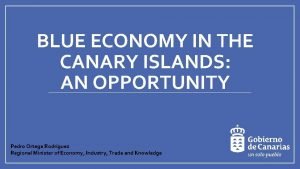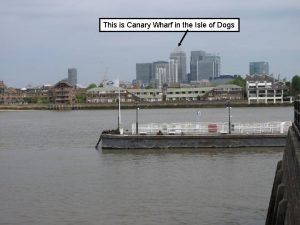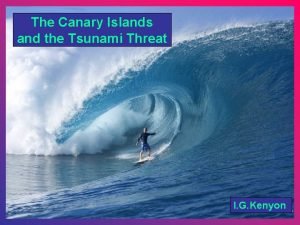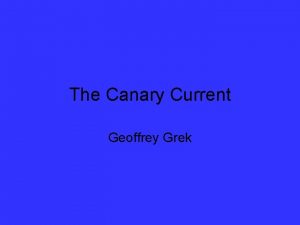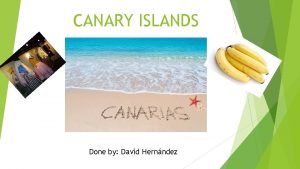The Canary Current Geoffrey Grek Canary Current Stats









- Slides: 9

The Canary Current Geoffrey Grek

Canary Current Stats • Flows North to South from 30°N to 10°N and offshore to 20°W • Very wide ~1000 km • Cold water due to upwelling along coast • On average 500 m deep and flows at 1015 cm/s • Canary Island Archipelago reaches depth of 3000 m and impedes path of current

The Canary Current • Eastern Boundary Current • Part of the North Atlantic Subtropical Gyre • Flows southwest along African coast • Causes upwelling on the African coast

The Canary Current • Eastern Boundary Current • Part of the North Atlantic Subtropical Gyre • Flows southwest along African coast • Causes upwelling on the African coast

The Canary Current • Driven by the trade winds • Current velocity dependent on trade wind velocity • Flow obstructed by Archipelago Island • Always flows towards equator

Canary Current Eddies • Form along the coastal boundary • Length scales of 100 to 300 km • Kinetic Energy values are less than 100 cm 2 s 2

Canary Current Eddies

Mass Transport • Northward mass transport is positive in Figure on right • Mostly southward mass transport • Northward mass transport is caused by Equatorial countercurrent

Resources • Joanna Gyory, Arthur J. Mariano, Edward H. Ryan, “The Canary Current” http: //oceancurrents. rsmas. miami. edu/atlantic/canary. html • Pablo Sangrà, Ananda Pascual, Ángel Rodríguez-Santana, Francisco Machín, Evan Mason, et. al. , 2009: The Canary Eddy Corridor: A major pathway for long-lived eddies in the subtropical North Atlantic, Deep Sea Research Part I: Oceanographic Research Papers, 56, 2100 -14. • A. Hernández-Guerra, F. Machín, A. Antoranz, J. Cisneros-Aguirre, et. Al. , 2002: Temporal variability of mass transport in the Canary Current, Deep Sea Research Part II: Topical Studies in Oceanography, 49, 3415 -26.





